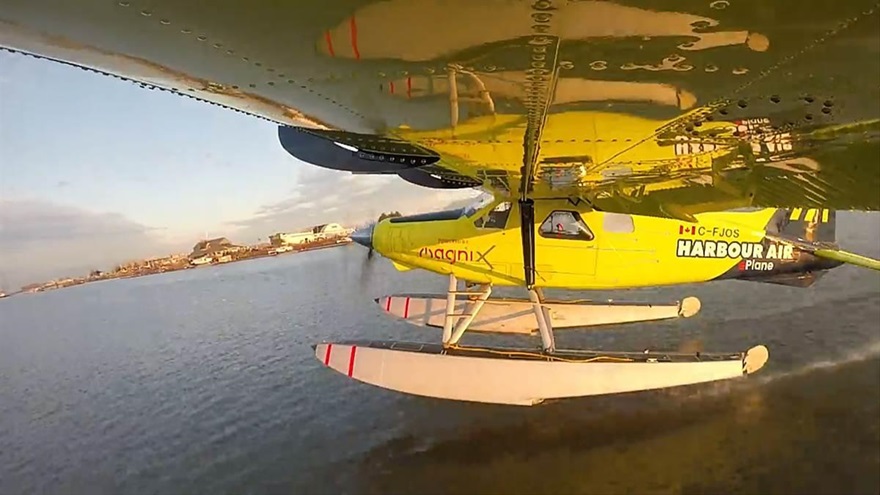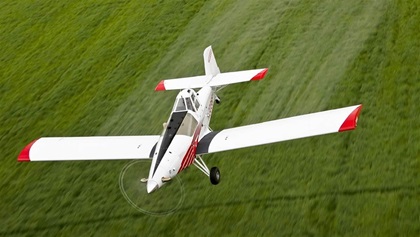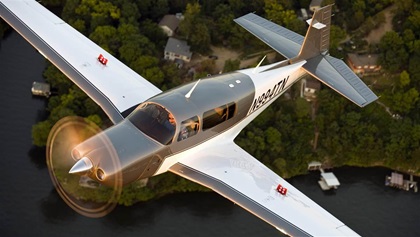
Pushing the boundaries
Harbor Air launches first all-electric airplane
By David Tulis
Harbour Air’s all-electric-powered de Havilland Beaver took off for an inaugural flight test just after daybreak in December 2019 to the cheers of about two dozen people huddled on a chilly dock in Vancouver, British Columbia, as the distinctive seaplane ushered in a new era of aviation.
Several thousand more also watched online as the yellow-and-navy magniX-powered seaplane retrofitted with a 750-horsepower magni500 propulsion system thundered into the air during a live social media broadcast.
The fossil-fuel-free aircraft partnership between North America’s largest seaplane airline and Redmond, Washington-based electric propulsion venture magniX was announced in March.
Roei Ganzarski, the CEO of magniX, had said the six-passenger Beaver was to be the test bed beginning in November. Strong storms that rolled through the Pacific Northwest pushed the timetable to early December.
When the idea of converting Harbour Air’s 42-aircraft fleet of de Havilland Beavers, single Otters, and Twin Otters over to electric power was announced in March, it caught traditional aircraft and engine manufacturers off guard.
Harbour Air’s business model as a mostly short-haul operator with an average flight time of 15 to 25 minutes on the airline’s routes provided a platform that was well suited to a battery-driven propulsion system that provides 30 minutes of flight plus a 30-minute reserve, he said.
At that time, Greg McDougall, founder and CEO of Harbour Air Seaplanes, said the company was “once again pushing the boundaries of aviation by becoming the first aircraft to be powered by electric propulsion.” The firm had previously purchased carbon offsets in 2007 with a desire to become “the first fully carbon-neutral airline,” he noted.
The electric motor manufacturer predicted that the tests would lead to certification in the United States and Canada, and would proceed on two tracks, beginning with approval of the propulsion system, and followed by application for a supplemental type certificate for the converted DHC–2 Beaver.
The goal is to accomplish the regulatory chores by 2021 “so that in 2022 people can buy tickets in an all-electric Beaver,” Ganzarski said.
Email [email protected]
Taking it old school
‘Classrooms’ offered as new aviation learning environment
By Dan Namowitz
How’s this for innovation: Instead of studying all alone for FAA knowledge tests by reading a book, watching a video, or answering test questions on an app, there’s a place where people gather to study aviation together and ask questions of a living, breathing instructor.
Sound intriguing? Then click your heels together three times, because when you open your eyes, you’ll be in Kansas.
Kirby and Teresa Ortega may be swimming against the technological tide by providing the ground school portions of pilot training courses in learning spaces that some of us will recognize as “classrooms.” But they are wily industry veterans, not starry-eyed risk-takers. They believe the service they offer to aviation students meets a real need.
Ortega Aviation Services, located at Wichita's Dwight D. Eisenhower National Airport, is offering its students a “live learning experience” for the ground school learning required for any pilot certificate or rating that requires a knowledge test endorsement.
That’s not to say it’s aviation unplugged. Smart boards, large displays, and Wi-Fi are used. Students get electronic tablets—theirs to keep—preloaded with all course materials and flight planners. Lessons are instructor-led but can include online presentations.
The first class of students, which included nine new private pilot aspirants and three pilots working on instrument ratings, wrapped up in November 2019. The initial class included two women and two high-school students, and enthusiasm ran high, Teresa Ortega said.
“Everybody jumped in with both feet,” she said, noting that the first group of private pilot students were so new to aviation that she found herself “going out to buy nine logbooks.”
The company is a flightless operation, said Teresa Ortega, a commercial pilot and the company’s managing partner. She said future classes should draw on a well-populated aviation community including employees of Textron Aviation, flying clubs, and the many other aviation organizations located in the “Air Capital” region, as the Wichita area is known for its long history of aircraft manufacturing. The students will tap outside resources for their flight training, also drawing on the Wichita area’s many options.
Kirby Ortega, a 24,000-hour pilot and a flight instructing hall-of-famer, believes you can still make a strong case for what might fairly be characterized as an old-school ground training program, because the human element can help keep a student pilot who has become discouraged with self-study from giving up.
The Ortegas are not the first industry competitors to critique abbreviated or self-study alternatives by asserting that those choices “only teach a student how to pass a test,” but don’t touch “the fundamentals of flying.”
By contrast, they say, Ortega students are not cut loose to take the FAA knowledge exam when classes are complete. If students need to tidy up their knowledge-test prep based on practice test scores—nailing 80 percent deems you ready for the real thing—the Ortega organization will still be there for them.
Following the upbeat initial classes, Ortega Aviation Services has posted the next class schedules online.
“Kirby and I have a huge passion for aviation,” she said. “His is teaching. Mine is fostering aviation in the younger generation.”
Web: ortegaaviation.com
Email [email protected]
Thrush restructures
Ag brand ‘well-positioned’ for growth and success
By Dan Namowitz
 Thrush Aircraft, the manufacturer of aerial application aircraft that filed for bankruptcy last year, announced completion of a restructuring that leaves the company “well-positioned for growth.” Mark McDonald has taken over as president and CEO of the Albany, Georgia-based Thrush from Payne Hughes, who stepped aside when the company announced layoffs and a Chapter 11 bankruptcy filing in August 2019.
Thrush Aircraft, the manufacturer of aerial application aircraft that filed for bankruptcy last year, announced completion of a restructuring that leaves the company “well-positioned for growth.” Mark McDonald has taken over as president and CEO of the Albany, Georgia-based Thrush from Payne Hughes, who stepped aside when the company announced layoffs and a Chapter 11 bankruptcy filing in August 2019.
“The past few years have been hard for Thrush and for all of our stakeholders,” McDonald said. “But the issues the company had to overcome had little to do with the quality of our product, and nothing to do with the quality of our people. Now, as we begin a new chapter in this legendary company’s history, I can tell you that, from the factory floor to the flight line, all of us are genuinely excited about the future of this great brand.”
Vice President of Sales Eric Rojek, who has been with the manufacturer of agplanes and firefighting aircraft since 2005, introduced the new management team to the industry and previewed the latest product news during the National Agricultural Aviation Association convention in November.
“Our customers around the world can continue to count on sales, deliveries, training, and support to continue at their best—and for each of our services to improve even more,” he said.
Reorganization “is often a fact of life in the aircraft industry,” Rojek said, adding that Thrush Aircraft has emerged “highly stable, and very well-positioned for growth and long-term success.”
Email [email protected]
 A series of American, French, and German ownership groups couldn’t make Mooney profitable—and neither, it seems, can Meijing Group of China.
A series of American, French, and German ownership groups couldn’t make Mooney profitable—and neither, it seems, can Meijing Group of China.

